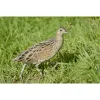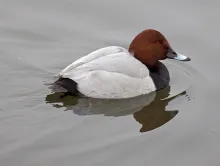
Common Pochard (Aythya ferina)
Species name
- Dutch name:
- Europese tafeleend
- English name:
- Common Pochard
- German name:
- Tafelente
- French name:
- Fuligule milouin
- Scientific name:
- Aythya ferina
Scientific classification
- Order:
- Anseriformes
- Family:
- Anatidae
- Onderfamilie:
- Aythyinae
- Genus:
- Aythya
Description
- Description:
Male:
Has Rufous-chestnut head, blackish breast, upper mantle, under tail-coverts, rump and tail, silver-grey flight feathers and almost white under wing, grey body, dark black Bill with light grey strap across bill between nostrils and tip of bill. And bright orange-red eyesFemale:
Has dull brown head with pale grey eyestripe, throat, lores and cheeks. Body grayish-brown, darker above. Wings generally browner than those of male. Bill dull grey/black with black tip and eyes brownJuvenile:
Has dull brown head with pale grey eyestripe, throat, lores and cheeks. Body greyish-brown, darker above. Wings generally brown. Bill dull grey/black with black tip and eyes brown. Males first winter start to get color in there plumage But, do not get adult plumage tell there 2nd winter.Key Facts:
Redhead A. americana very similar but Larger .Male A. ferina has red rather than yellow iris, different pattern on bill, female A. ferina has different bill colour and whiter flanks. Male A. ferina smaller than Canvasback A. valisineria, which is paler with blackish wash to head, flatter forehead and much longer, all-dark bill).
Also cunfused with Canvasback A. valisineria x Redhead A. americana - The hybrids have bright blue randomly across the bill or just in patches. A. ferina has a light grey band between nostrils and tip of bill. The Hybrids well also be Bigger being a cross of two larger pochards.
Standard Measurements
- Body Length (cm):
- The male (drake) of the Common Pochard measures approximately 42-49 centimeters. The female measures approximately 42-49 centimeters.
- Body Weight (grams):
- The male will weight about 830-880 gram. The female will weight about 800-825 gram.
The weight is notoriously variable and can only be used as indication!
- Habitat:
Common pochards are diving ducks which spend most of their time on water, and are ungainly on land. They are generally hardy, sociable and easy to maintain in captivity. They should be kept with deep water available for diving, three to seven feet suggested, or at least half the area 60cm and preferably one metre deep, with shallow sloping banks for easy exit from the water, also islands, good marginal vegetation and loafing areas. Water providing a good supply of natural animal and vegetable food is preferred.
These ducks may be kept in mixed collections with dabbling ducks, including smaller species such as teal. They should be fed wheat in water, encouraging their natural diving behaviour. Pellets should also be fed. They may breed better if a group rather than single pair kept, as this allows their normal group displaying activity.
30x30x35cm nest box with 12.5cm entrance hole suggested, placed under cover at the edge of the pond.
- Note:
Common pochards are winter-hardy, easy to maintain, and not aggressive. These ducks are fairly easy to breed, lay in ground level nest boxes, nest baskets or holes above the water or in dense bankside vegetation, from April to May. They sit well but high losses are common in parent-reared ducklings. They will often lay a second clutch if the eggs are removed. Hand rearing the ducklings is not difficult; water should be provided for swimming from the beginning. Ducklings require much live food (e.g. insects, mealworms).
This species hybridises readily, particularly with Brazilian teal - (Amazonetta brasiliensis), Ferruginous pochard - (Aythya nyroca), Tufted duck - (Aythya fuligula) and other Aythya spp. (hybrids with Aythya species are often fertile); also hybridises with Anas spp., Netta spp. and Common goldeneye - (Bucephala clangula).
- Breeding:
- The female Common Pochard usually lays from 8-10 green-grey or olive eggs and incubates them for 24-28 days.
- Artificial incubating:
The ideal relative humidity for incubating most waterfowl eggs is 55% (ground nesters) and 40% (cavity nesters). The temperature is usually 37.4°C. Set ventilation as recommended by the incubator manufacturer. Eggs must be turned, either automatically or by hand, a minimum of 4 times a day. As the duckling develops there is a loss of water from the egg and the air sac gets bigger. In normal development of an egg with a 24-28 days incubation, the air sac occupies about a third of it three days earlier. Cleanliness is vital and ideally eggs should be moved to a separate hatcher at this point, where the humidity should be increased to 65% and even higher once they have pipped internally.
- Bird banding:
- Recommended closed leg band ring size for the Common Pochard is 10 mm.The leg band ring can only be applied on a young diving duck at around 12-14 days old.
- It doesn't matter what leg that you band, but it's good to have a consistent system. Suggested: Left leg = Female, Right leg = Male
- Rearingfeed:
-






 Floatable special rearing feed for all ornamental waterfowl species, even for problematic eaters. This ideally balanced complete feed with 35% protein content forms the basis for healthy growth and lifelong vitality. Made exclusively from wholesome and selected raw materials, Lundi Micro is also ideally suited for the year-round feeding of waterfowl.
Floatable special rearing feed for all ornamental waterfowl species, even for problematic eaters. This ideally balanced complete feed with 35% protein content forms the basis for healthy growth and lifelong vitality. Made exclusively from wholesome and selected raw materials, Lundi Micro is also ideally suited for the year-round feeding of waterfowl.
- Maintenance food:
-





Floating full food for all sea ducks, green ducks, eider ducks and geese, especially in the moulting and breeding phase ideally suited. Packed with wholesome raw materials, natural vitamins and trace elements, this performance food with a protein content of 30% forms the basis for lifelong vitality.
- Regulation:
- This species is listed on Schedule 3 - Part 3 (Birds which may be sold alive at all times if ringed and bred in captivity)
- Regulation:
Notes on the revised schedules state "Birds which may be sold dead from 1 September to 28 February (NB: It is illegal to offer for sale at any time of the year any wild goose, moorhen, gadwall or goldeneye, although they are legitimate quarry species outside the close season)) of the LUK2 - Wildlife and Countryside Act 1981 of the United Kingdom.



